Every browser has its own default search engine to make online search easy for users. For instance, Chrome and Safari iOS use Google, while Edge uses Bing.
But what if you don’t like the browser’s default search engine? Lucky for you, every standard browser — Google Chrome, Firefox, Edge, Internet Explorer, Safari, and Opera — allows you to change which search engine it uses. Often, they also include options to add custom search engines from across the web.
The exact process depends on your browser and device. Whether you’re a mobile or computer user, we’ll give you detailed instructions on how to change the default search engine.
Check Out Our Video Guide to Changing the Default Search Engine:
What Is the Default Search Engine?
Did you know that your browser’s address bar isn’t just for visiting websites? You can also use it to search the web automatically.
Every web browser has its own default search provider. When you attempt to search the address bar, it will automatically redirect you to the site preferred by your browser.
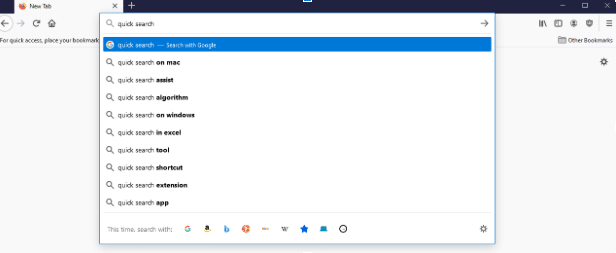
It’s a lot faster than manually visiting a site like Google and then typing your query since you can skip an entire step. But if the default search engine is a site you’re not fond of, you may want to change it.
You can always visit your search engine of choice by typing its web address into the address bar, but there’s no reason to go through all that trouble when you can set it as the default search engine, then access it right in the address bar.
Wondering what the default search engine even is? Here’s the complete list for all major browsers covered by this guide:
- Chrome: Google
- Firefox: Google (previously Yahoo)
- Edge: Bing
- Internet Explorer: Bing
- Safari: Google
- Opera: Google
While Google is the popular default choice for most browsers, you can pick the one you prefer. Many browsers come preloaded with a list of other search engines to choose from, or you can add your own.
Why Change Your Browser’s Default Search Engine?
There is one big reason you might want to switch it up: Google tends to be the go-to default for most browsers. But it’s no big secret that Google is tracking you, and some users are uncomfortable with the invasion of privacy. If that’s you, you may not even want to search with it accidentally.
Alternatives like DuckDuckGo, a search provider dedicated to protecting your anonymity, maybe a better alternative if you have privacy concerns. This search engine is now a default choice on many privacy-focused browsers (e.g. Brave browser).
On the other hand, Edge users may prefer Google over Bing. They may also dislike breaking from standards, considering that almost every major browser uses Google, the most popular search engine.
You may also not want to use a dedicated search engine but a smaller website’s search function. For instance, if you use your device primarily for research, you could make Wikipedia your go-to quick search tool.
Or it all may simply come down to personal preference.
How to Change the Default Search Engine (All Browsers)?
Whatever browser you may be using, regardless of whether you’re on a computer or a mobile device, changing the default search engine shouldn’t be hard. If you’re unsure where to start or where to find the proper settings, these tips will walk you through every step.
1. Google Chrome
With Google Chrome open, first look for the row of triple dots in the top right corner of your screen. Click it, then near the bottom, find the Settings button.
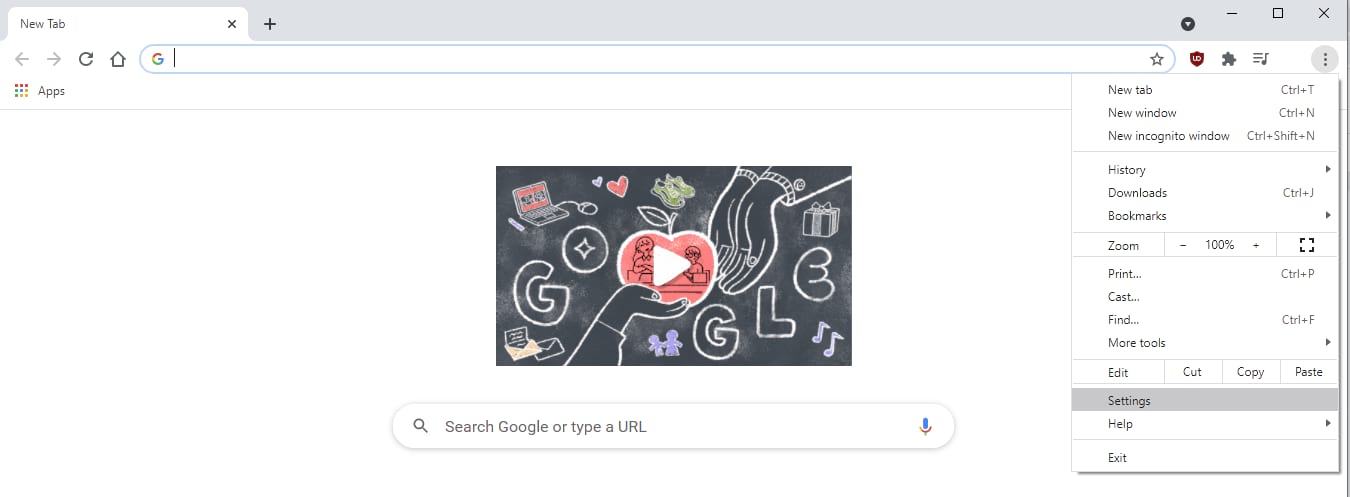
Open the Settings page, then look to the left for a quick link to the Search engine tab, or scroll until you find it.
You should see a drop-down menu to the right of the Search engine used in the address bar option. Click it and pick the search engine you like.

Alternatively, you can click Manage search engines, then click the vertical three dots next to the one you want and select Make default.
Mobile users: Open the Google Chrome app and tap the three dots next to the address bar, then Settings.
Find the Search engine under the Basics section. Then select the search engine you want to use.
2. Firefox
Look for Firefox’s menu button, resembling three horizontal lines, in the top right corner. Then click the Options link located next to a gear symbol to open the Settings menu.
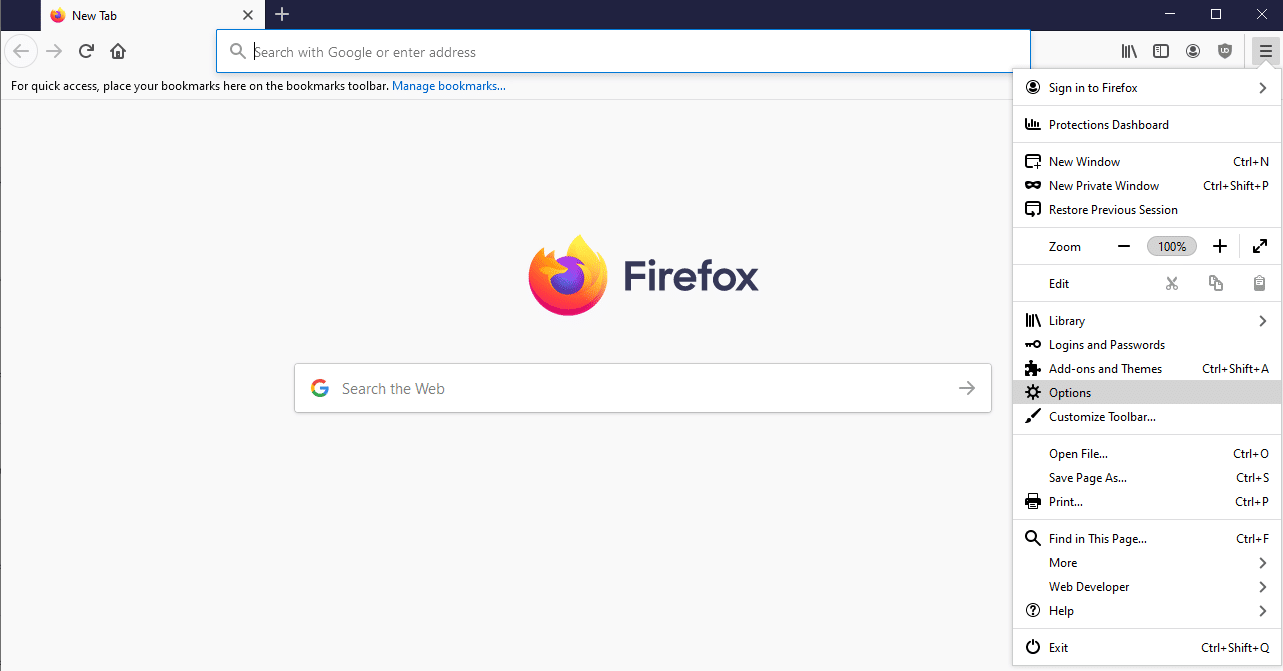
There should be a Search button with a magnifying glass icon on the left side of the screen. Click it to bring up Search options.
Look for the Default Search Engine section with a drop-down. Firefox comes with six defaults: Google, Amazon, Bing, DuckDuckGo, eBay, and Wikipedia. Select the one you like.

Mobile users: Tap the menu button next to the address bar, which looks like a vertical row of three dots. Tap Settings, then on the Settings page, Search. You’ll see a list of default search engines to choose from here.
3. Edge
You can find Edge’s settings by clicking the horizontal line of dots at the top right of the screen, then Settings. Click Privacy, search, and services, scroll to the Services section, then click the Address bar and search at the very bottom of the list.
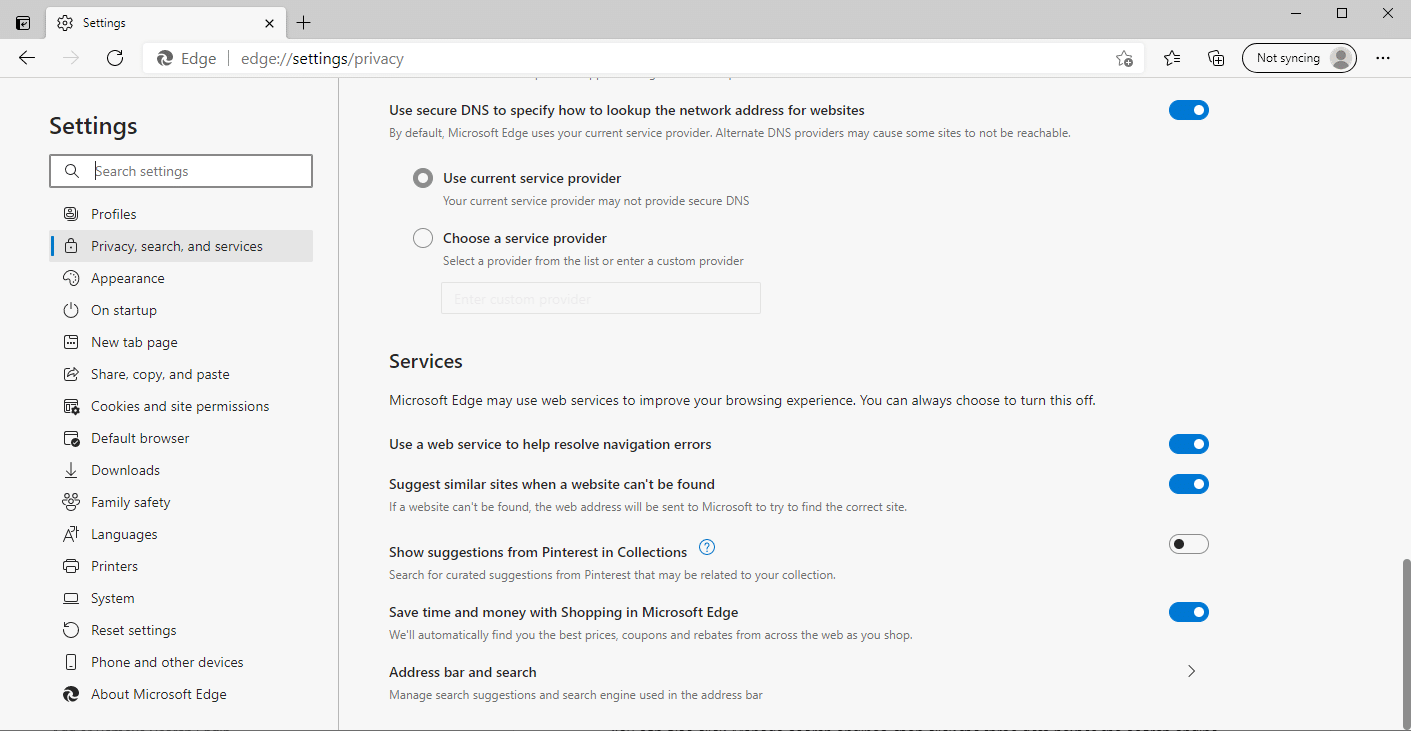
You should see a section labeled Search engine used in the address bar with a dropdown menu. You can pick from Bing, Yahoo, Google, DuckDuckGo, and YouTube by default.
You can also click Manage search engines, then click the three dots next to the search engine you want to use and click Make default.
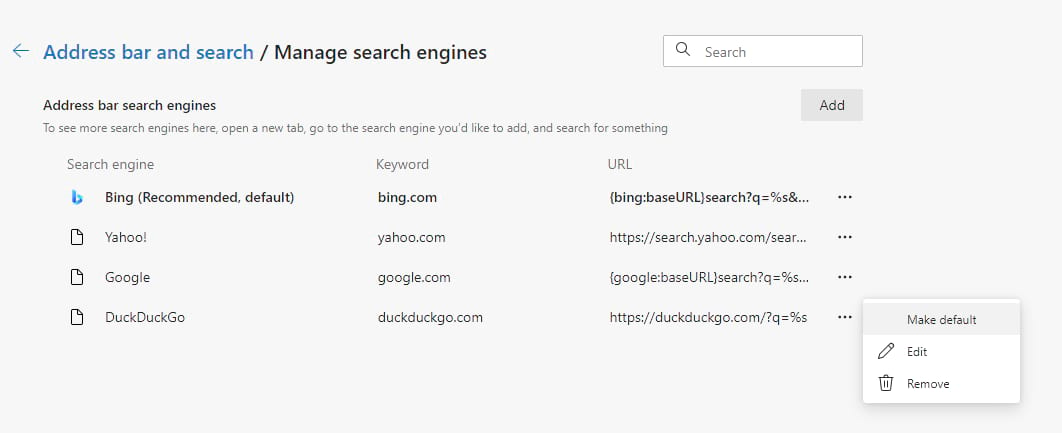
Mobile users: To find your settings, tap the row of dots on the screen’s bottom bar and click Settings. Under Advanced, look for the Search option. Select the Default search engine, then select from the list of search providers.
4. Internet Explorer
Internet Explorer is an unsupported browser, and we recommend you update to a modern browser for security reasons. However, many people still use it today, especially in legacy corporate environments where users have no choice but to use outdated applications.
The process of changing your default search engine on IE is a little more confusing, but you can still do it.
To get to the settings, click the gear symbol at the top of the screen, then Manage add-ons.

In the window that pops up, look beneath Add-on Types, then click Search Providers. By default, Bing is the only provider listed.
If you’ve added other search engines, select the one you prefer and then click Set as default.
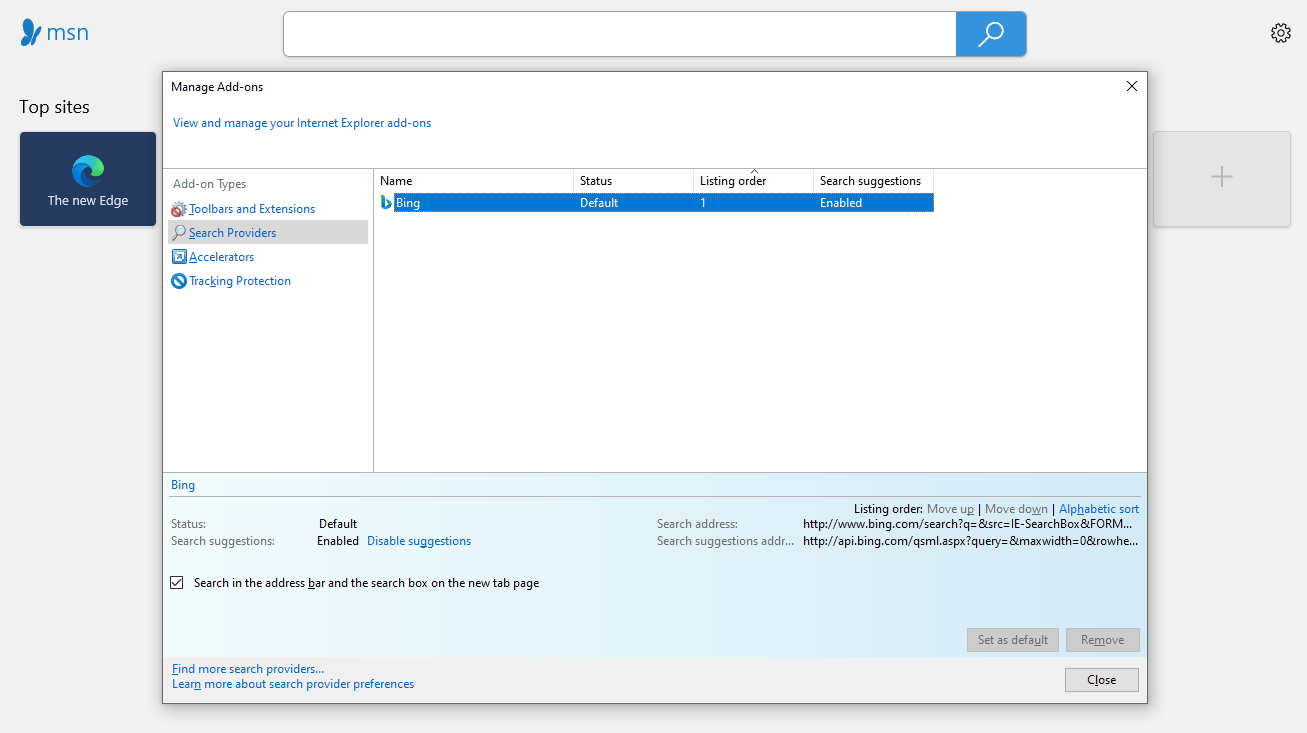
5. Safari
As the default browser for Apple devices, you can use Safari on both iPhone and Mac. While Safari versions exist for other operating systems, they’re outdated, and you should avoid them.
If you use Safari on a MacBook or iMac, look for the menu window along the top of your browser. Choose the first option, which is Safari, and click Preferences. Next, tap the Search tab at the top of the screen. You have your choice of Google, Bing, Yahoo, Ecosia, or DuckDuckGo.
iOS users: Instead of looking in the browser itself, open your phone’s settings and look for the Safari section. Beneath Search, tap Search Engine. You have the same five search engines to choose from as in the desktops.
6. Opera
Open Opera’s settings by clicking the gear on the left-side panel. Scroll down to the Search engine section and look for the dropdown next to the Search engine used in the address bar. You can pick between Google, Yahoo, DuckDuckGo, Amazon, Bing, and Wikipedia.

Mobile users: Open Opera and tap the logo in the bottom right of the screen, then tap Settings. Scroll until you see the Default search engine listed under Search.
You have a few extra options compared to the desktop version: Google, Yahoo, Bing, DuckDuckGo, Amazon, eBay, IMDB, and Wikipedia. Select the one you want from the list.
How to Add or Remove a Custom Search Engine?
Let’s say you add your favorite search engine, but you find it isn’t on the list. What then?
If that’s the case, you’ll have to put it in manually. While this is easier on some browsers than others, all but Safari and Opera Mini have some way to add search engines other than the default ones they provide.
You might also notice that your list contains websites you’re not interested in, as they’re sometimes added to the list automatically. If this annoys you, you can remove them.
Luckily, these settings aren’t far from where you change the default search engine.
1. Google Chrome
By default, Google Chrome only includes Google, Bing, Yahoo, DuckDuckGo, and Ecosia in the list of default search engines. If you have a different one in mind, you’ll have to add it manually.
Open the settings page for Chrome by clicking the three dots in the top right corner followed by Settings, and scroll until you reach the Search engine section. Then click Manage search engines.
To add a search engine, click Add next to Other search engines and fill out the field.
- In the Search engine field, add a label. It can be whatever you want.
- In Keyword, enter a word or URL you want to trigger the quick search function in Chrome. For example, to start Google’s quick search function, type “google.com” in the address bar and press Space on your keyboard.
- Finally, enter the search URL. To find the correct URL, search the site you want to add. Your URL may look something like
http://www.example.com/search?q=kinsta. For this example, replacekinstawith%sto leave your initial query blank.
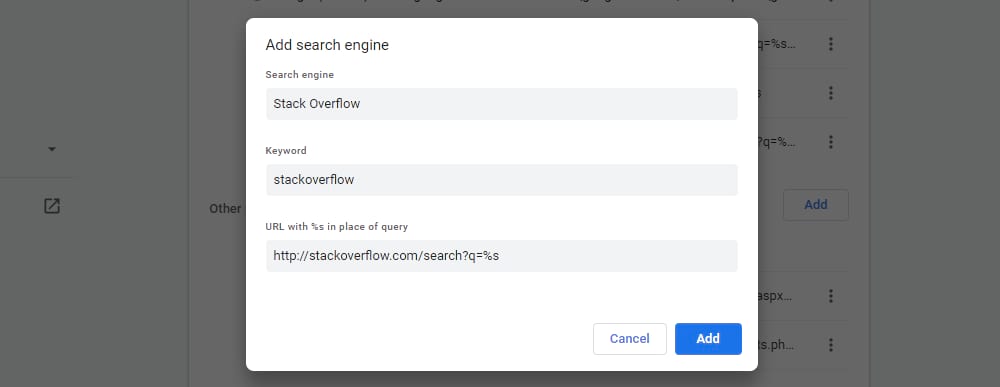
Alternatively, you can visit your preferred search engine site and search there to add it to your browser’s list automatically.
You can also delete search engines, including default engines. Just click the row of dots next to them, and then click Remove from list.
Mobile users: There’s currently no way to add a custom search engine manually, but you can automatically add it by visiting the website you want to add and performing a search. You can then find it on your settings page under Basics > Search engine.
2. Firefox
Firefox comes with a variety of ways to add new search engines.
To add them through the Settings page, open the menu next to the address bar, then go to Options, followed by Search. Scroll to the bottom of the Search page and click Find more search engines. You can then download a Firefox extension that will add search tools to your browser.
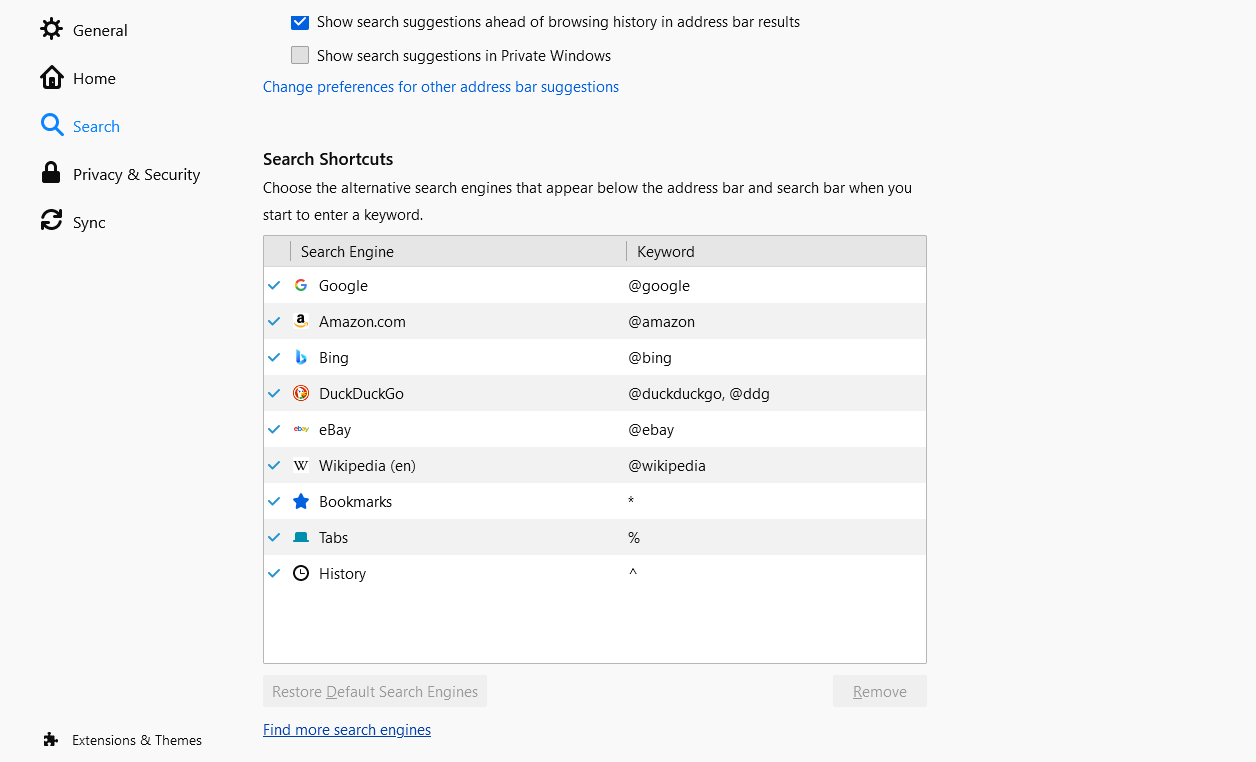
If you don’t want to download an extension, there are other options.
First, visit your search engine’s website. If you’ve enabled the separate search bar in Search settings (located next to the address bar), you’ll see a green plus symbol appear over the magnifying glass icon. Click it, and you should see an option to add your search engine.
If you’re not using the search bar, click instead on the horizontal row of three dots in the address bar. Then click Add Search Engine.

Removing a search engine is easy. On the Settings page, scroll to Search Shortcuts and highlight the search engine you want to delete. Click the Remove button, and Firefox will delete it from your search shortcuts and the Default Search Engine dropdown.
If you used an extension to add the search engine, then you’ll need to uninstall that extension.
Mobile users: Oddly enough, Firefox for Android includes adding search engines manually, whereas its desktop version doesn’t.
Tap the menu button to visit the Settings page, then go to the Search settings. Tap Add search engine, then Other. Name the search engine, then place the URL in the Search string to use field.
Like Chrome, you need to get the proper URL by visiting the website and searching. Copy the URL, then replace the query you entered with %s.
3. Edge
Much like Firefox, Edge relies on the OpenSearch standard to automatically add in search engines as you browse. To add a search engine, visit its website and search. You should then be able to replace your default search engine in the settings as discussed previously.
This rule applies whether you’re on the desktop or mobile version of Edge.
You can also add a search engine by visiting Settings > Manage search engines and clicking Add. It’s identical to Google Chrome’s prompt for adding search engines — enter a label for the website, a keyword to activate quick search functionality, and finally link the URL with %s replacing your search query.
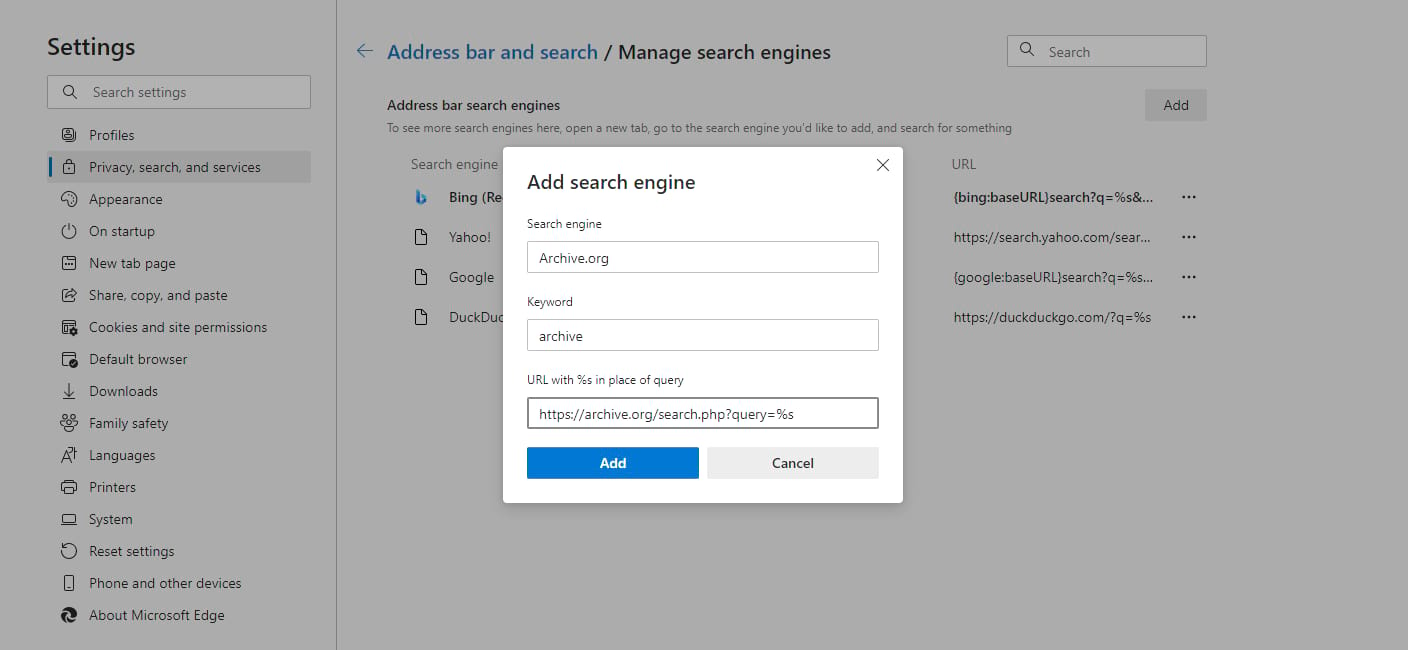
Removing a search engine requires visiting Settings, clicking Manage search engines, and clicking the three dots. Then click Remove to delete them.
4. Internet Explorer
Open the Settings page by navigating to Tools (gear symbol) > Manage add-ons > Add-on Types > Search Providers. Since Internet Explorer only comes with Bing, you’ll need to include additional engines manually.
At the bottom of the pop-up window, click Find more search providers. From there, you can install various addons that will allow you to search with different engines.
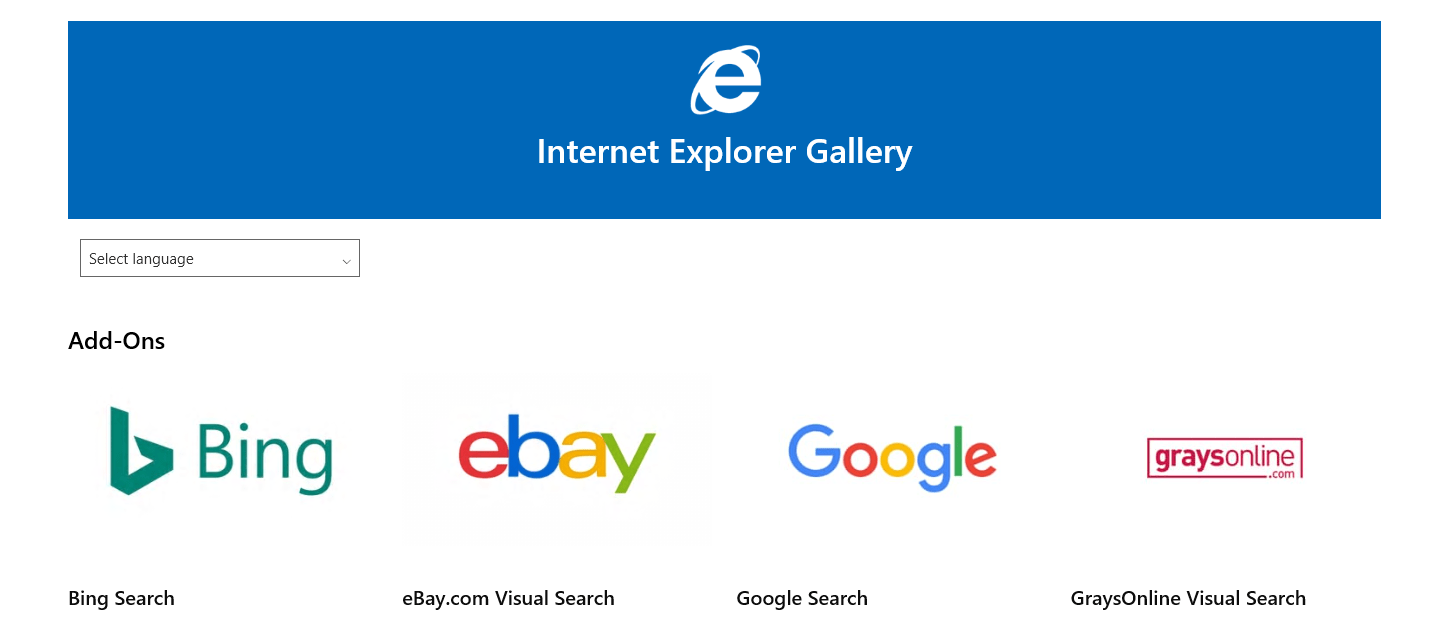
Remove a search engine you installed, select it in the Search Providers list, then click Remove.
5. Safari
Unfortunately, there is no built-in way to add additional search engines in Safari for iOS or Mac. You can still manually navigate to a website to use its search feature, but there’s no way to add their quick search to your Safari address bar.
You may be able to look through Safari’s built-in Extension Library for a plugin, such as Anysearch, which allows you to add new search engines to your list.
6. Opera
In Opera’s settings, under Search engine, look for the button labeled Manage search engines. Next, click Add, and you’ll see a window where you can manually add in your favorite search provider.
As usual, enter the search engine’s label, a keyword to activate quick search (for example, typing “g” into Opera’s address bar will initiate a quick Google search), and the search URL with %s swapped out in place of your query.

One thing is different here compared to other browsers that allow you to add search engines manually: Opera supports websites such as StartPage, which use POST HTTP request methods rather than GET. Unless you know you’re using such a site, leave this box blank.
You cannot delete any of the default search engines, as they’re part of the browser. But if you’ve added a website you no longer want, click the line of dots next to it and select Remove from list.
Mobile users: There is currently no way to add a custom search engine to Opera Mini or remove any from the default list.
Summary
Most people have a strong opinion on which search engine is best. It can be frustrating when your browser defaults to the one you don’t like.
Luckily, changing your search engine and adding in a better one is an easy task on any device. No matter how unconventional your preferred search engine is, it should work perfectly as long as you follow these instructions.
Unfortunately, some browsers, especially mobile browsers, may not support manually adding search engines — and some don’t support adding extra search engines at all (e.g. Safari).
If you find yourself struggling to use a search provider you like, often your best option is to switch browsers. You can always check out the browser market share for 2021 to see if a better alternative exists.


